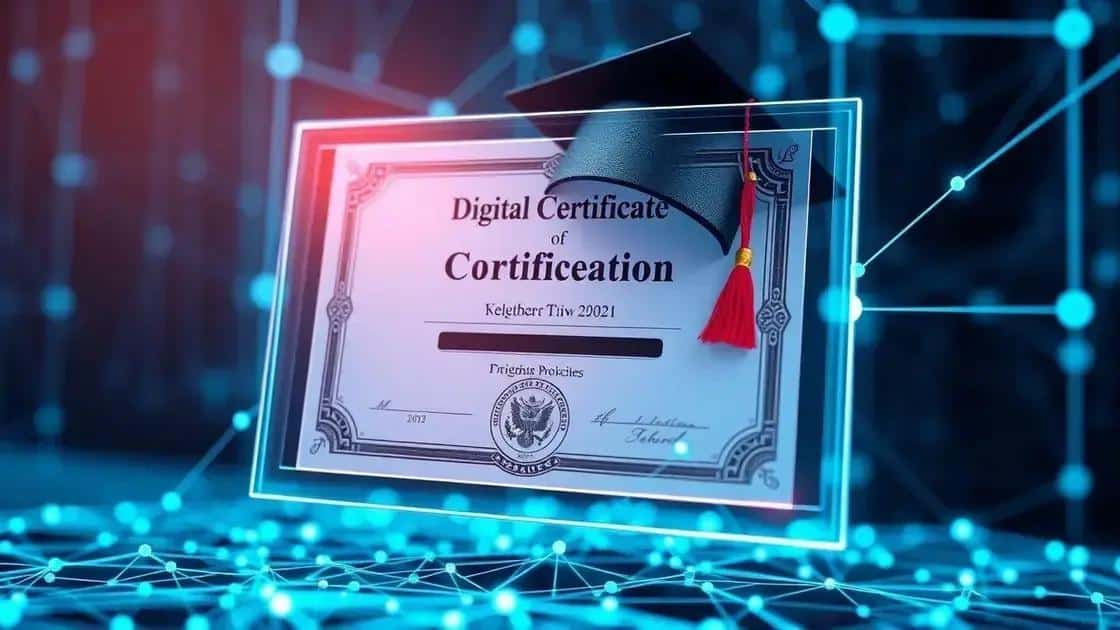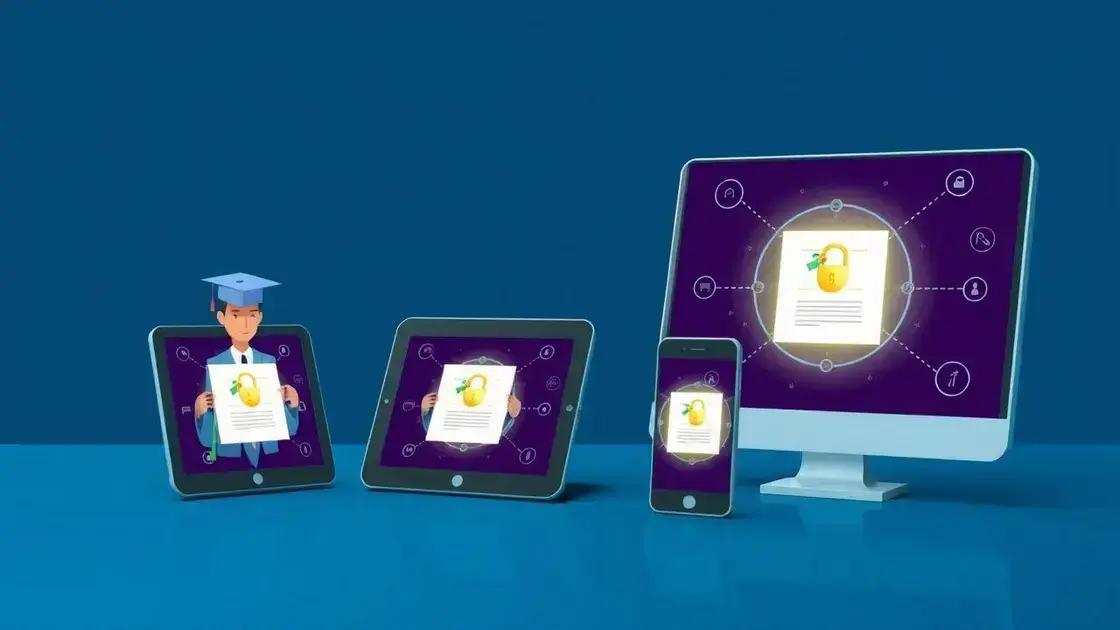Blockchain for academic credentialing: transforming verification

Blockchain for academic credentialing enhances security, accessibility, and trust in verifying credentials while also streamlining processes through automation and real-time validation.
Blockchain for academic credentialing is an exciting development that promises to change how qualifications are verified. Have you ever wondered how this technology can simplify the verification process for students and employers alike? Let’s dive deeper into its advantages and implications.
Understanding blockchain technology
Understanding blockchain technology is essential to grasp its potential impact on various sectors, especially in academic credentialing. At its core, blockchain is a distributed ledger system that records transactions across many computers. This ensures that the recorded information cannot be altered retroactively without altering all subsequent blocks, which greatly enhances security.
Key Features of Blockchain
Several key features make blockchain a valuable tool:
- Decentralization: Unlike traditional systems, no single entity controls the Blockchain network, increasing transparency.
- Immutability: Once data is recorded, it becomes nearly impossible to change, providing a reliable history of credentials.
- Security: Advanced cryptography protects the data, making it very secure against unauthorized access.
Moreover, the technology allows for smart contracts, which are self-executing contracts with the terms of the agreement directly written into code. This feature can automate various processes involved in credential verification, reducing time and errors.
When universities and institutions use blockchain, they can create a secure digital record of students’ achievements. This not only helps in maintaining accurate records but also solves the problem of fraudulent degrees and credentials. Employers can verify academic qualifications quickly and efficiently, ensuring that the information is both accurate and up-to-date.
Blockchain Networks
There are different types of blockchain networks:
- Public blockchains: Open for anyone to join, these networks are decentralized and highly secure.
- Private blockchains: Restricted and controlled by a single entity, these are used within organizations to secure internal transactions.
- Consortium blockchains: These are governed by a group of organizations, combining benefits of public and private systems.
By understanding the differences among these types of blockchains, stakeholders can determine which is most suitable for their credentialing needs. In conclusion, the power of blockchain technology lies in its capacity to transform how academic credentials are stored, verified, and shared. As institutions explore this potential, we can expect to see more robust and secure verification processes in the near future.
Advantages of blockchain in credentialing

The advantages of blockchain in credentialing are significant and transformative. One major benefit is the ability to securely store and share educational credentials online. This innovation not only simplifies the verification process but also enhances trust.
Enhanced Security
Blockchain technology offers unparalleled security compared to traditional methods. By using cryptographic methods, data stored on the blockchain remains secure from tampering or unauthorized access. This security is essential for ensuring that academic records are both accurate and reliable.
- Fraud Prevention: The immutability of blockchain records makes it extremely challenging for someone to falsify their credentials.
- Real-Time Verification: Employers and institutions can verify credentials in real-time, speeding up the hiring process.
- Data Ownership: Students have more control over their academic data, allowing them to share it as they see fit.
Another important advantage is the reduction of administrative costs associated with credentialing processes. By automating verification through smart contracts, institutions can save time and money. This efficiency can lead to a more streamlined experience for both students and employers.
Improved Accessibility
Blockchain also enhances accessibility to academic records. Since these records are stored digitally, they can be accessed from anywhere in the world. This feature is particularly beneficial for online learners and international students.
Furthermore, the transparency afforded by blockchain means that stakeholders can easily track changes made to records. This transparency fosters accountability and trust between students, academic institutions, and employers.
Overall, the advantages of blockchain in credentialing not only improve security and efficiency but also create a more reliable system for verifying academic achievements.
Challenges in adopting blockchain for education
The challenges in adopting blockchain for education encompass various technical and practical issues. As educational institutions explore this technology, they encounter obstacles that could hinder wide-scale implementation.
Technical Limitations
One of the main technical challenges is the scalability of blockchain systems. Many early blockchain platforms struggle to handle large volumes of transactions efficiently. This limitation can be problematic for institutions that need to verify numerous credentials quickly.
- Transaction Speed: Some blockchains take longer to process transactions, making them less feasible for real-time verification.
- Interoperability: Different blockchain platforms may not communicate effectively with each other, complicating the sharing of academic records.
- Cost: Maintaining a blockchain system can be expensive due to the need for strong hardware and energy consumption.
Furthermore, educational institutions may lack the expertise to manage and implement blockchain solutions effectively. Training staff and developing a solid understanding of the technology require time and investment.
Regulatory and Compliance Issues
Another significant challenge involves regulatory compliance. Educational institutions must navigate complex legal frameworks concerning data protection and privacy laws. For example, storing personal data on a blockchain raises concerns due to the immutable nature of blockchain technology, which can conflict with regulations like the General Data Protection Regulation (GDPR).
Additionally, the evolving nature of blockchain technology can make it difficult for institutions to adapt their policies and procedures. Keeping up with changes in technology while ensuring compliance can be a daunting task.
While the benefits of blockchain in education are promising, the challenges in adopting blockchain must be addressed to fully realize its potential. Institutions need to weigh the pros and cons carefully as they consider integrating this groundbreaking technology into their systems.
Future of academic credentials with blockchain

The future of academic credentials with blockchain is bright and full of possibilities. As educational institutions continue to explore this innovative technology, the landscape for credential verification is set to change dramatically.
Increased Accessibility
One key aspect of this future is increased accessibility for students around the globe. By using blockchain, educational records can be stored digitally and accessed from anywhere with an internet connection. This means that students can easily share their qualifications with potential employers without the need for paper transcripts.
- Instant Verification: Employers can verify credentials instantly, reducing the time spent on hiring processes.
- Global Standards: Blockchain technology can help establish a universal standard for academic credentials, making it easier for institutions and employers to understand qualifications from different countries.
- Empowerment: Students will have more control of their academic record, allowing them to decide how and when to share their information.
Moreover, the use of smart contracts will automate various administrative tasks related to credentialing. This automation can lead to quicker enrollment processes and more efficient record-keeping.
Enhanced Trust and Transparency
Another important aspect of the future is enhanced trust in the academic credentials. The transparent nature of blockchain allows anyone to view the history of changes made to a credential. This transparency builds trust among students, institutions, and employers.
As educational institutions adopt blockchain, they can also integrate innovative features such as digital badges that recognize specific skills and achievements. These badges can be easily shared on social media and professional networks, showcasing a student’s unique qualifications and experiences.
Finally, the future of academic credentials with blockchain may lead to new models of education, where students can accumulate and share their achievements in real-time. This promotes lifelong learning and continuous skill development, essential in today’s fast-paced job market.
FAQ – Frequently Asked Questions about Blockchain in Academic Credentialing
What is blockchain technology?
Blockchain is a secure and decentralized digital ledger that records transactions across multiple computers, making it nearly impossible to alter past records.
How does blockchain enhance security in academic credentials?
Blockchain uses cryptography to secure academic records, ensuring that they cannot be easily tampered with or forged.
What are the benefits of using blockchain for educational institutions?
Using blockchain allows for faster verification of credentials, increased accessibility for students, and greater trust in the information shared.
What challenges do institutions face when adopting blockchain?
Challenges include technical limitations, regulatory compliance issues, and the need for staff training to effectively implement and manage the technology.





